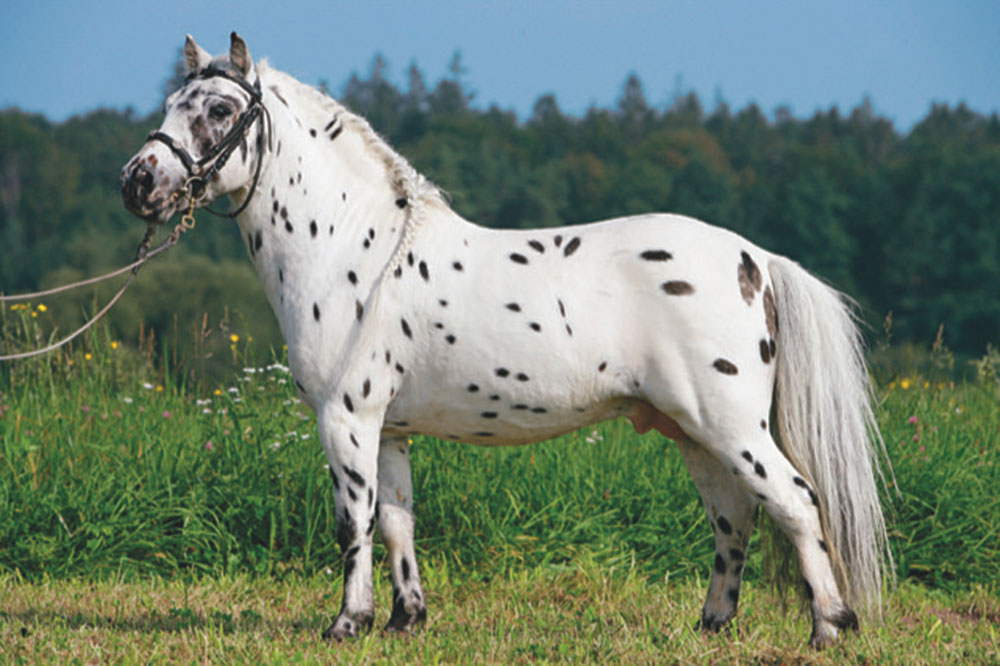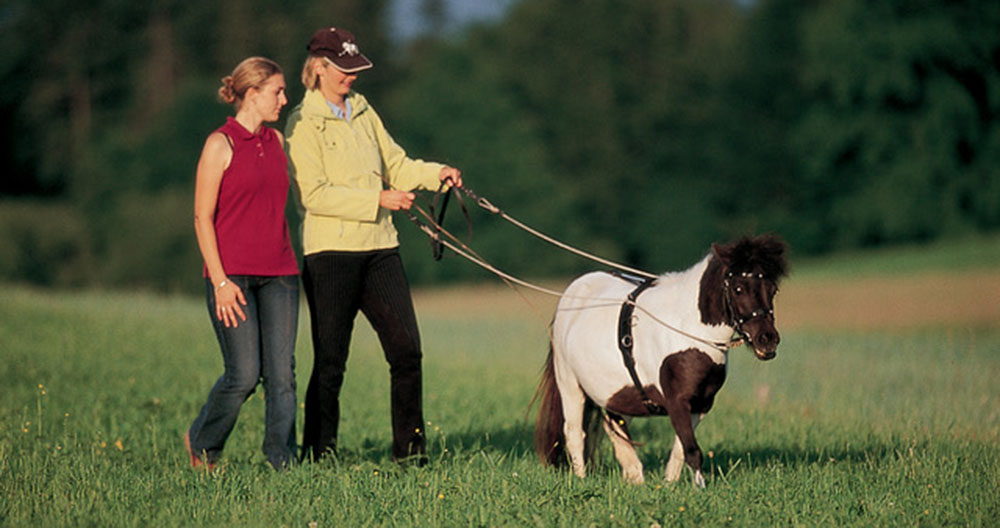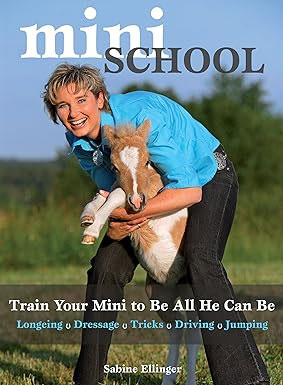
The following is an excerpt from Mini School – Train Your Mini to Be All He Can Be, by Sabine Ellinger
Today’s stylish and perfectly proportioned Miniature Horses are the product of nearly 400 years of selective breeding. Classically elegant, gentle by nature, and appealing to people of all abilities, sizes, and ages, this small and unique equine stands no taller than 34 inches at the withers as measured from the last hairs of the mane. The American Miniature Horse Association (AMHA) has established an official “Standard of Perfection” in which the general impression of the Miniature Horse should be “A small, sound, well-balanced horse, possessing the correct conformation characteristics required of most breeds, [including] refinement and femininity in the mare [and] boldness and masculinity in the stallion. The general impression should be one of symmetry, strength, agility, and alertness. Since the breed objective is the smallest possible perfect horse, preference in judging shall be given to the smaller horse, other characteristics being approximately equal (www. amha.org).
The Importance of Conformation
Severe conformation flaws can still occur but not to the extent that was the case 20 years ago. The modern-day Mini has been bred with more emphasis placed on his suitability for driving and riding. Quality of the gaits, jumping ability, conformation, and temperament have all been enormously improved in the past two decades because in addition to the suitability for specific disciplines, breeders have put a strong emphasis on breeding and creating a cooperative and friendly a Mini as possible.
Conformation flaws usually won’t really affect a Mini’s ability to perform tricks, but they can pose difficulties when training him in dressage, driving, or jumping. Minis often do not have ideal conformation because many breeders select their breeding stock with a focus on small size rather than on other physical parameters. Poorly set necks, improperly angled or weak hindquarters, a lack of room in the throatlatch, and bad bone structure can make training and conditioning a Mini for an equestrian discipline much more difficult and in some cases nearly impossible.
The same criteria that apply to the conformation of full-size horses are relevant in Minis. Thick throatlatches limit the horse’s ability to flex at the poll, weak hindquarters hinder collection, and crooked legs make the horse less resilient over time. The Mini’s smaller size and the fact that he is not ridden—or at least not ridden to the same degree his full-size cousin is—makes the severity of the problems relative.
Evaluating Conformation
When selecting a Mini for training, the buyer should choose one that resembles a “scaled-down” version of a normal-size riding horse. With a critical eye, you’ll want to evaluate the following points:
Head
A Mini should have a kind face with big, expressive eyes. You can tell a lot about his character just by looking at his facial expression. The shape of the head is not so important but a “clean” throatlatch is crucial. A thick throatlatch makes it very difficult for a Mini to “give” at the poll, which should be as moveable as a ball bearing. Wide cheek bones combined with a thick throatlatch area are quite common and are unfortunately very limiting.
-
Neck
A correctly shaped neck enables correct contact with the bit and the handler’s hands, and thus establishes a better connection with the Mini. Ewe-necks, “swan necks” (those that are unusually long and set on too high), and low-set necks are much more difficult to work with to achieve an optimal connection with the Mini’s mouth. The neck should be wide at the base, set relatively high, and should taper gradually and harmoniously up to the poll.
-
Shoulders
An elastic, swinging stride can only come out of a well-angled, sloping shoulder. Minis with upright shoulders tend to hurry and “shuffle along.”
-
Back
A well-shaped, gently curved back of an appropriate length facilitates dressage and driving training. The development of impulsion (forward thrust generated by the hindquarters) and carrying capacity (ability of the hindquarters to assume more of the Mini’s weight and reverse his natural heaviness on the forehand), and everything else that comes from the hind end relies on a “swinging” and supple back. Swaybacks and roach backs are stiff and inflexible, making it harder for the Mini to perform.
-
Croup
If a croup-high Mini is asked to collect (an optimal state of balance with more weight over his lowered hindquarters and with a gently rounded topline), he must expend vastly more energy than one with better hind end conformation. Most collected movements, depending on the degree of collection required, may not be possible for a croup-high Mini.
-
Hindquarters
The hindquarters are the Mini’s engine! It is hard for a Mini to compensate for conformational flaws in this area. Correctly angled hind legs make collection immensely easier. The hindquarters should be as broad as possible from the top down in order to allow enough room for optimal muscle development.
-
Bone Structure
The Mini’s legs carry his body. For him to withstand work, he should have clean legs and feet. They should be straight and without serious conformational defects. The legs will have to withstand stress if the Mini is to jump, or perform collected movements or “airs above the ground”. More pronounced joints are usually more resilient. Otherwise the legs should be “clean” with no spongy spots or bumps.

Although you may not care to always be “looking for a problem,” you must be able to recognize and evaluate conformational faults in a prospective Mini purchase. There are some that do not hinder a Mini’s training and should not discourage a buyer. However, there are others that make any sort of work—in hand or in harness—a constant challenge, despite the Mini’s best efforts. Such a Mini must work many times harder to achieve the same results as one with good conformation. When you are informed about what good and poor conformation looks like in a Mini, you will be better able to create a training program that is suitable for the Mini with whom you are working.

BUY NOW ON AMAZON
Hardcover | Paperback
This excerpt from Mini School was published with permission from Trafalgar Square Books. You can also visit them at Horse & Rider Books.
There a more really interesting books on riding and all aspects of equestrian living in our section on Books.

































